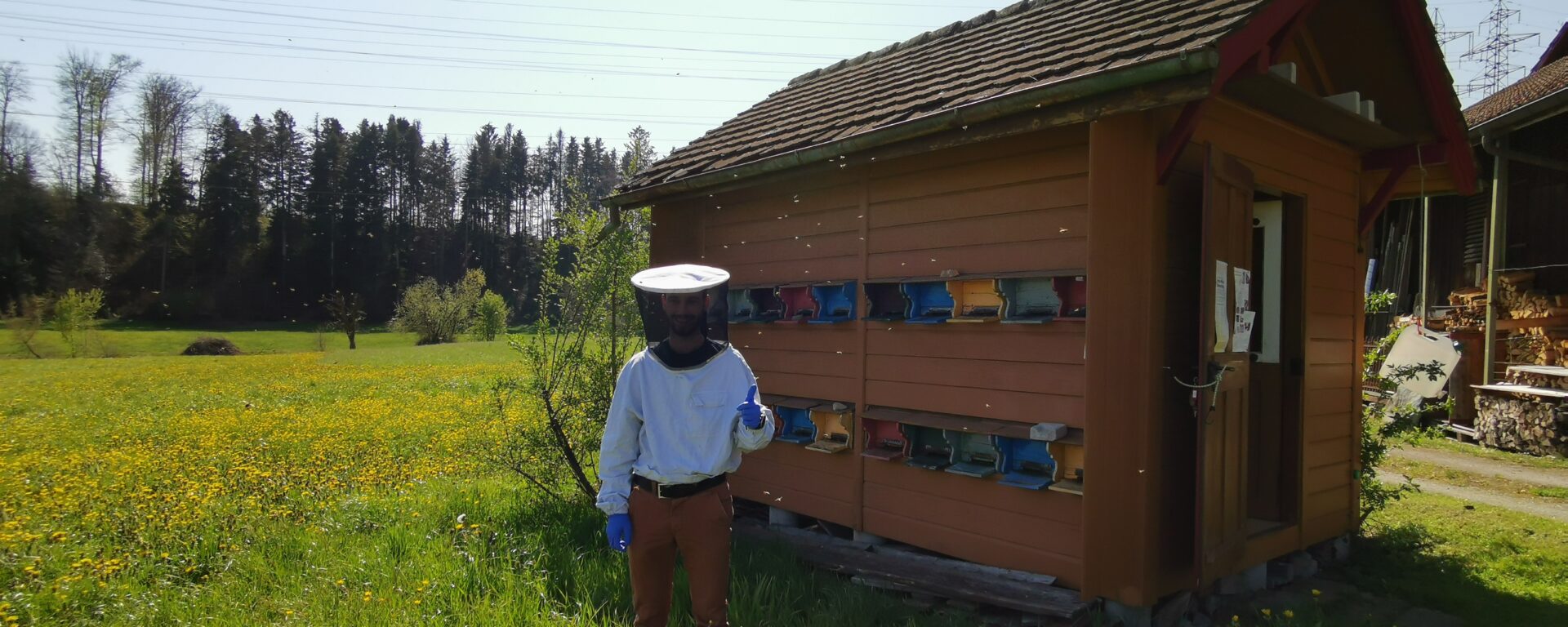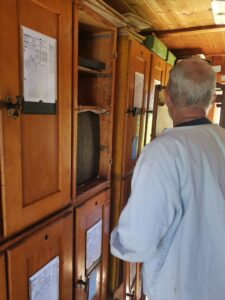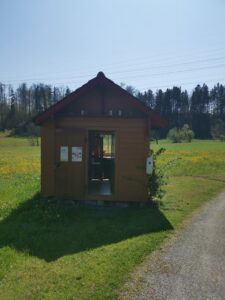Introduction
Bees are fascinating insects. They are hard workers. For three years, I’m the owner of my own little bee house for wild bees.


I like observing the bees and give them a place to live. They don’t need much, just a hole with a corridor behind, where they can nest. And this all in a closed wooden container. You can create a bee house for yourself or check the website of Wildbiene + Partner (wildbieneundpartner.ch) and get yourself inspired. You can choose between different houses and subscriptions, depending on your wishes and plans. Each bee house has a fitting price. They send you a delivery once a year with a small tube with larvaes in it. This little tube you can insert easily in the bee house and then put the house to a sunny place.
During the next few days, when the weather is good enough, the wild bees hatch from their cocoon and start exploring the surroundings and pollinate flowers. The wild bees only pollinate, they don’t produce honey. It’s also possible to put the bee house on a balcony in a city centre. The wild bees will find flowers to pollinate everywhere. They fly in an area of two kilometres and will live between four and six weeks. In this time, they nest and lay their little eggs as well, in the corridor of the bee house. Once they’ve done this, you can recognise that by seeing that the hole with their eggs in it is closed. They transport some dirt on the front of the hole to protect the eggs from wind and weather.
Intention
My intention is to inform the people of the importance of bees for our vegetation, and through this also the importance for our trees and plants. I asked a few of these environmental questions to Mr. Bieri, who works with bees as a beekeeper. The main reasoning of his answers will surprise you:
Mr. Bieri is sure, that the bees will overcome the global climate warming, because bees have existed for so long, and they had to overcome so many other problems and could get over them every time. They are very adaptable, luckily.
Facts
Below I will show you some very important facts about bees:
- A honey bee colony can contain up to 80,000 animals in summer.
- About 25,000 species are known and there are still many more to be discovered.
- Pollination by bees corresponds to an economic annual value of 150 billion euros.
- A working bee visits up to 2000 flowers per day.
- A flight distance of up to 145,000 kilometers is necessary for 1kg of honey.
- 75% of the 100 most important cultivated plant species are dependent on insect pollination, of which bee pollination accounts for 80%.
Source: Book “Das Bienenbuch; Bienen verstehen, schützen und halten” from the Dorling-Kindersley-Verlag
Collaboration
One of our tasks was to collaborate with some other students from India or Basque Country. They also worked on the “dontwastemyenergy-community” on different works about the environment. We started the collaboration work with a skype-conference, where we talked together about our tasks and every team presented their own task. After this, we formed groups with similar tasks, so that we can collaborate together. Unfortunately, the connection to my two sparring partners from the Basque Country interrupted after a short time. They stopped replying to me, so at one point, I gave up the collaboration work and focused again full time in my own work.
Kurz-Zusammenfassung Interview mit Herr Bieri
As I wrote above, I took the chance to meet a beekeeper, and I spent a full afternoon in his own bee house. He showed me his passion and answered me the following questions:
1) Wie lange imkern Sie schon?
15-20 Jahre. Wussten lange nicht, was für ein Haustier wir uns für die Familie zulegen sollen. Dann waren wir mal im Imkermuseum Grüningen, das hat den Kindern und mir gleich gefallen und darauf habe ich ein Imkerkurs besucht. Ich konnte das bestehende Häuschen am Egelsee von einem Vorgänger übernehmen, da dieser schon älter war.
2) Was fasziniert Sie an den Bienen?
Die Eigenschaften der Biene haben mich stets fasziniert. Es hat nie aufgehört mit neuen Erkenntnissen zu den Bienen. Ich kann selber züchten, man ist in einem Verein, es findet ein Austausch statt. Ausserdem gefällt es mir, ein Produkt von Grund auf selber zu produzieren und schlussendlich dieses mittlerweile sogar zu vertreiben. Man ist selbständig und kann sich die Zeit aufteilen. Der ganze Kreislauf der Biene gefällt mir. Die Geschichte der Biene ebenfalls, mit all den Veränderungen, die sie schon durchgemacht haben.
3) Wie oft sind Sie bei den Bienen?
Eigentlich sind die Bienen ja selbständig, wenn ich vorbeigehe, störe ich sie eher. Aber den Sommer durch bin ich schon fast jedes Wochenende dort, vor allem bei schönem Wetter, da ich dann besseren Zugang zu den Bienen erhalte, weil sie dann grösstenteils am ausfliegen sind. Ich habe mittlerweile 10 Völker, das gibt natürlich schon Arbeit. Vor allem dann die Honiggewinnung Ende Sommer sowie das Auffuttern im Herbst. Ab Ende September will ich sie nicht mehr stören und ich lasse sie arbeiten den Winter durch. Verluste zwischen 10-20% den Winter durch sind normal. Im Winter kommt jedoch das Abfüllen des Honigs und der Vertrieb dazu, damit es mir nicht langweilig wird.
4) Was sind momentan die aktuellen Gefahren für die Bienen?
Das schlimmste Problem was sie momentan haben, ist die Varoa. Das ist ein Parasit, welcher durch eine asiatische Bienensorte vor ca. 40 Jahren eingeschleppt worden ist. Die hat man eingeschleppt, da man dachte, dass eine Kreuzung mit asiatischen Bienen ertragreicheren Honig geben würde. Leider hat das nicht funktioniert, dafür hat man nun den Parasit als Resultat. Die Varoa heftet sich an die Bienen und legt ihre Eier in die Bienenwaben. Das ist ein Problem, aber mittlerweile kann man die Bienenwaben und die Bienen dagegen behandeln, mit natürlicher Säure (Ameisensäure). Die Varoa sowie elektrische Leitungen und die Klimaveränderung sind eine Belastung für die Bienen, aber sie sind sehr robust und anpassbar, da sie das in der Evolution schon immer sein mussten.
5) Wie sieht die Bienensituation heute in der Schweiz aus?
Die Dichte ist wieder ziemlich gut. Es sind jüngere Leute am Werk und es hat einen Wandel gegeben. Früher haben es Bauern nebenan noch gemacht, heute machen es Imker als Hobby, aber sie sind meiner Meinung nach besser informiert und geben sich mit viel Hingabe hin. Es ist nämlich arbeitsintensiver, als man vielleicht denkt.
6) Was halten Sie von der Wildbienen-Aktion wie derjenigen von Wildbiene + Partner?
Ich selbst habe zuhause auch ein solches Häuschen. Ich finde es eine gute Sache. Vor allem braucht man für die Wildbienen fast keine Arbeit, die arbeiten für sich und man kann sie lassen. Als Imker fehlt natürlich etwas der Anreiz, da sie kein Honig produzieren und man mit ihnen nicht arbeiten kann. Wildbienen sind nicht blütenbeständig, sie springen von Blüte zu Blüte, die normale Biene sucht sich am Morgen einen Baum aus und bleibt den ganzen Tag an diesem Baum. Das sorgt für eine bessere Bestäubung.
7) Wie weit fliegen die Bienen, um zu bestäuben?
Sie fliegen einen Umkreis von max. 2 Kilometern. Aber natürlich gehen sie nur soweit wie nötig, ganz klar. Deshalb dürfen auch nicht mehrere Imker innerhalb dieses Radius sein, sonst vermischen sich die Völker. Mit diesem Radius finden sie in der Schweiz auch ohne Probleme überall etwas zu bestäuben, selbst in der Stadt, z.B. in Zürich. Oder auch im Wald, dort holen sie den Honig aus den Läusen, welche ein zuckerartiges Sekret absondern.
This interview took place on Saturday, 24. April 2021, at the bee house of Mr. Bieri, near the Egelsee in Bubikon
Below, I share some pictures from my visit at the bee house:

Conclusion
I took the decision of my task very seriously. I was motivated from the first second and this helped me to get through some troubles during my work. As I mentioned, the collaboration work didn’t really exist, unfortunately. Also was it difficult for me, to set my aims right. We had a long time to work on this and had a timetable. I didn’t reach this everytime, but I always tried at least. The visit with the beekeeper and now the writing are these two tasks, that I am most happy about, because these are things, which are active and practical parts, which I like most. 🙂
References
All references that I used for my work, I already mentioned during my work.
I hope you enjoyed it. Thanks for your attention, and hey, think about me next time, when a bee flies around your head. They are on the way to an important mission. 🙂
Enjoy the videos I added below. Thank you for your attention.
Author: Florian Baumann, WKVW, TZ21
Sources
- Book Das Bienenbuch; Bienen verstehen, schützen und halten (dorlingkindersley.de) from the Dorling-Kindersley-Verlag
- Cut outs of the interview with Mr. Bieri (with use of his knowledge)
- Wildbiene + Partner (wildbieneundpartner.ch), seller of my own bee house, use of their development to manage the wild bee’s
- All pictures, videos and audios were taken by myself
This work was edited and overviewed by Karla Jovic
☷ See the project teams here »
☵ Some words about the contributions »
☴ Our sponsors and partners » (the-horse.education)



At first I thought it would be cool to keep a few bees on the balcony and earn a small pot of my own honey every year! But I see that this does not work with wild bees. 🙂
But as I can see, beekeeping in a small bee house seems feasible and makes sense and fun. Maybe I will give it a try next spring. Nice post.
May the bees be with us!